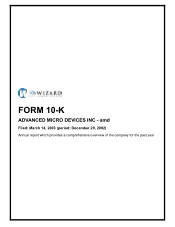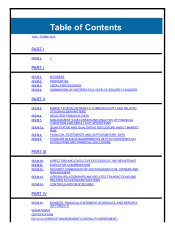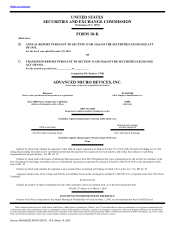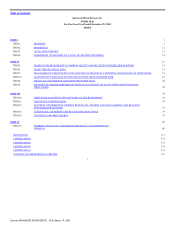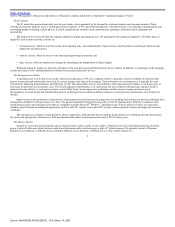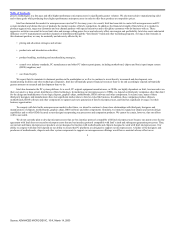AMD 2002 Annual Report Download - page 8
Download and view the complete annual report
Please find page 8 of the 2002 AMD annual report below. You can navigate through the pages in the report by either clicking on the pages listed below, or by using the keyword search tool below to find specific information within the annual report.
Table of Contents
include Flash memory, Read-Only Memory (ROM), Erasable Programmable Read-Only Memory (EPROM) and Electrically Erasable Programmable Read-Only
Memory (EEPROM) devices.
We primarily produce Flash memory devices. We also sell a very limited number of EPROM devices as sales of EPROM devices have been steadily
declining for the past few years as customers switch over to Flash memory devices. Several factors have contributed to an increasing demand for memory devices
in recent years, including the:
• increasing use and functionality of cellular phones;
• increasing use of PCs to perform memory-intensive graphics and multimedia functions;
• volume of memory required to support faster microprocessors;
• proliferation of increasingly complex PC software; and
• increasing performance requirements of workstations, servers and networking and telecommunications equipment.
The Flash memory market has grown significantly over the past five years. Flash memory devices have a size and cost advantage over EEPROM devices,
which utilize a larger, more expensive memory cell. Flash memory devices also provide greater flexibility and ease of use when compared to other non-volatile
memory devices, such as ROM and EPROM, because Flash memory devices can be electrically rewritten to update parameters or system software. ROM devices
cannot be rewritten and EPROM devices require information to be erased using ultraviolet light before they can be rewritten. Flash memory devices can be used
to provide storage of control programs and system-critical data in communication devices such as cellular telephones and routers. In networking applications,
Flash memory devices are used in hubs, switches and routers to enable systems to store firmware and reprogrammed Internet addresses and other routing
information. Flash memory devices are also used in PC cards. PC cards are inserted into notebook and sub-notebook computers or personal digital assistants, or
PDAs, to provide added data storage.
The Personal Connectivity Markets
We are entering the system-on-a-chip, or SoC, embedded microprocessor market for personal connectivity devices. Embedded processors are general
purpose devices typically used in products with a single or a limited number of applications. These products have limited user interface and programmability. We
are targeting personal connectivity devices in four main product segments: computing devices such as smart handheld devices, web pads, thin clients and PDAs;
access devices such as gateways, routers and access points; entertainment devices such as set-top-boxes, portable gaming and music devices; and automotive
driver information devices such as in-car navigation and entertainment systems. The applications software running on these devices typically requires highly
integrated SoCs that have high performance, low power embedded microprocessors.
Reporting Segments
In 2002, we participated in the digital IC market through our Core Products and Foundry Services segments. Our Core Products segment consists of our
microprocessor products, memory products and other IC products. In 2002, microprocessors included our AMD Athlon™ and AMD Duron™ microprocessors.
Memory products included Flash memory devices and EPROM devices. Other IC products included embedded processors, platform products, which primarily
consist of chipsets, and networking products. Our Foundry Services segment consisted of fees from Legerity, Inc., our former voice communication products
subsidiary, and Vantis Corporation, our former programmable logic devices subsidiary, for products sold to them. We sold Legerity in 2000 and Vantis in 1999.
In June 2002, we closed the fabrication facility where we manufactured products for Legerity and Vantis, although we continued to sell products to them that we
manufactured before the facility closed. In 2003, we do not expect any further sales to Legerity. We may continue to sell products to Vantis through the third
quarter of 2003.
3
Source: ADVANCED MICRO DEVIC, 10-K, March 14, 2003

